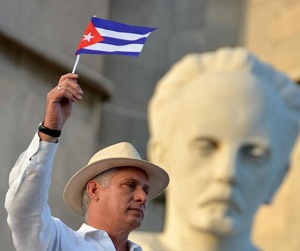 With pleasure I have read dozens of messages posted on the Presidency’s website, regarding the January call to pay just tribute to the most universal of Cubans. Some of these are so beautiful they make you want to reproduce them as graffiti.
With pleasure I have read dozens of messages posted on the Presidency’s website, regarding the January call to pay just tribute to the most universal of Cubans. Some of these are so beautiful they make you want to reproduce them as graffiti.
Although only names or pseudonyms are written, no professions or ages, it is very comforting to note that, in addition to numerous well-known followers of Martí, the majority are educators and young people interested in making their feelings about Martí public.
Ela, an early childhood teacher, has written that she was very moved when she talked about Martí with children in the fifth year of life, and they immediately, spontaneously ran to embrace and kiss the bust, where they place flowers every morning.
Enrique, a young professional, proudly recounts that, as a child, he played the part of Martí in a parade in his hometown, Placetas, and that when he graduated from the University he carried the Cuban flag to the top of Turquino Peak to pay tribute to him.
As Yamaris Pedraza states, “Every Cuban has a Martí inside, we have all read and performed his works, his thoughts.”
And how are Martí’s thoughts illuminating us! I have friends with good memories who constantly quote him to prove that he talked about everything, that he touched on every subject, and that in his writings we can find answers to the most difficult questions. Our schools could organize contests to find statements by Martí that are useful to human growth. You would see what a source of ethical values would flood them.
I once heard Pedro Pablo Rodriguez, director of the critical edition of his Complete Works, say that the man who lived only 42 years, left a truly infinite legacy. So frequently and constantly do new things appear in relation to Martí that his work seems to never end.
This work, and that generated by its study in Cuba and around the world, is already on social media, where young people share it and understand, in the end, that there is a great deal of Martí to be learned within his prose and verse that fascinate them. They discover with emotion that he is not a man of the last century but of all centuries.
But is this Martí? Many ask, amazed at the extraordinary validity of his statements and the universality of the issues he addressed.
When the newest – be they children or youth – discover that the man of the Golden Age also wrote wonderful things for adults, about the world order and the dangers that still beset us, it becomes impossible for them to escape from the need to turn to him. If they find him and delve into his essence, nothing can separate them from the charms of his words. And they become invincible.
Nonetheless, as Marti himself said in the Cuban Revolutionary Party’s manifesto to Cuba: “The homeland is sacred, and those who love it disinterested, tirelessly, owe it the whole truth.”
I do not want to exaggerate, nor can I. Martí is not yet as we would like him to be, and as he needs to be, to enrich the souls of our children and our children’s children. We continue and will continue to need Martí, always. And it is our responsibility to teach him, wisely and lovingly, as only good parents and good teachers can.
A blow from the depths of hatred recently shook our consciences in relation to the pernicious routine that allows us to forget care of Marti’s busts. Not the physical works that have accompanied us since childhood, but their integrity, what they symbolize.
Subsequent events came along to show us what it means to be with Martí, on the side of those who love and found. Or against Martí, on the side of those who hate and destroy.
Today is February 24; 125 years have passed since the beginning of the most noble of wars. The one Martí organized and led, defining it as “a complete, humanitarian war, in which the people of Cuba, invincible and indivisible, are even more united.”
In the Montecristi Manifesto, Martí and Gomez invoked, “as a guide and support for our people,” Cuba’s “magnanimous founders, whose work renews the grateful country, and honor, which prevents Cubans from wounding, in word or deed, those who die for them.”
It was March 25, 1895, on the eve of the long journey that would bring them back to the homeland, where veteran patriots and a new generation were already fighting for independence, who only Martí could move and bring together with his enormous faith “in human improvement and the usefulness of virtue.” This faith sustains our legendary resistance. Let us all take care of it by going deeply into Martí.